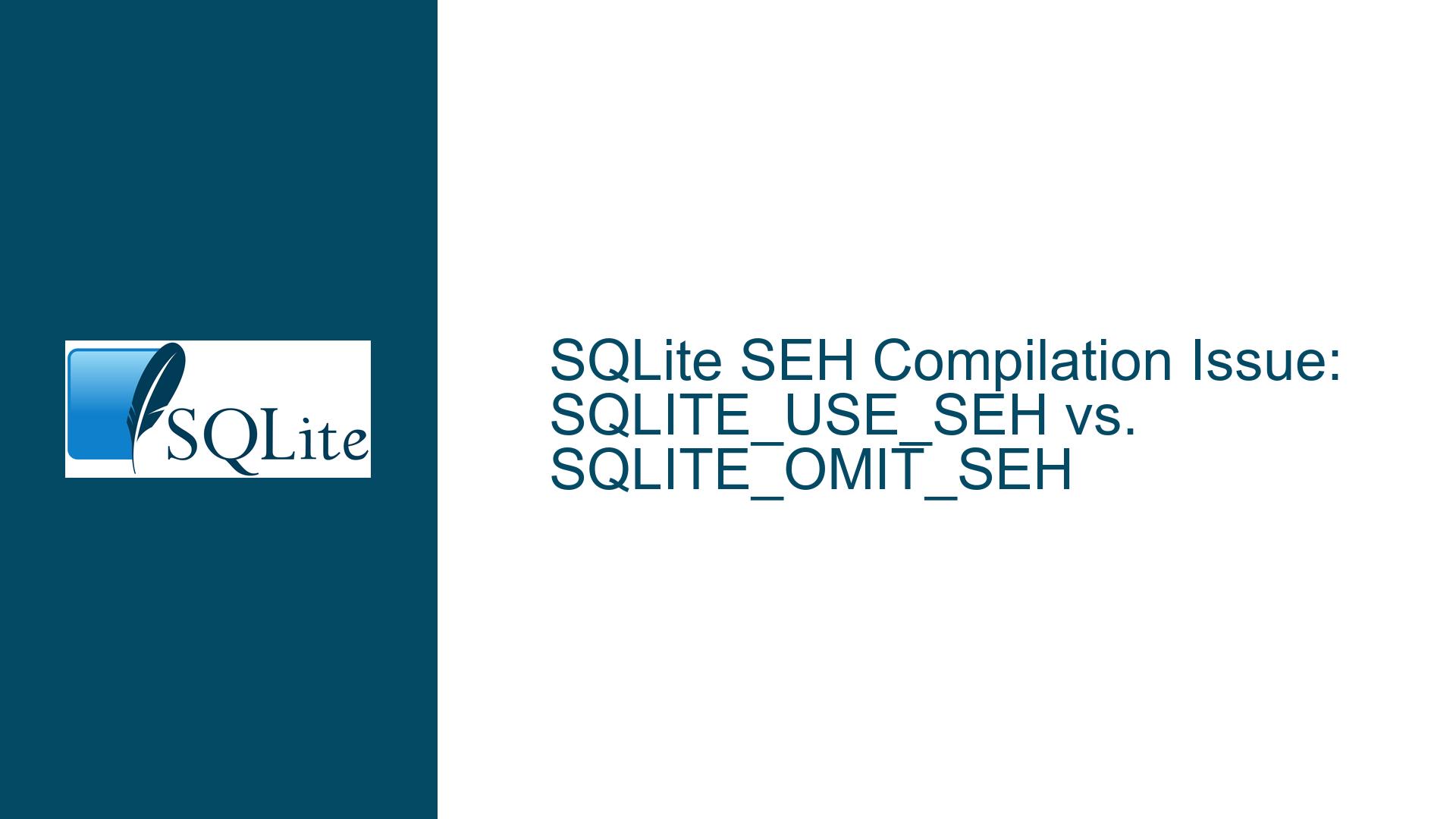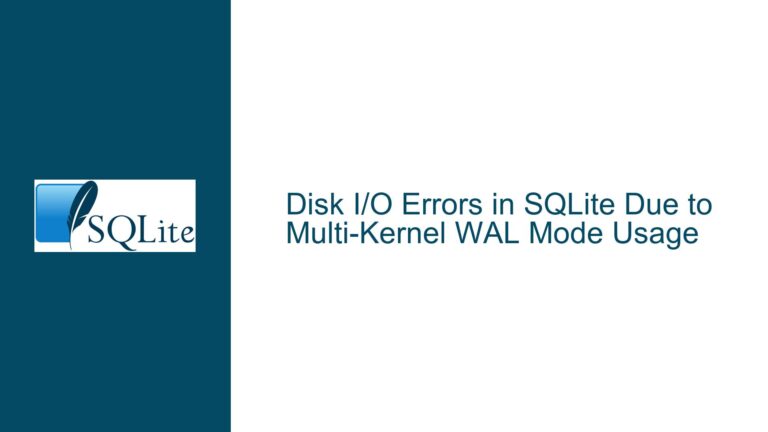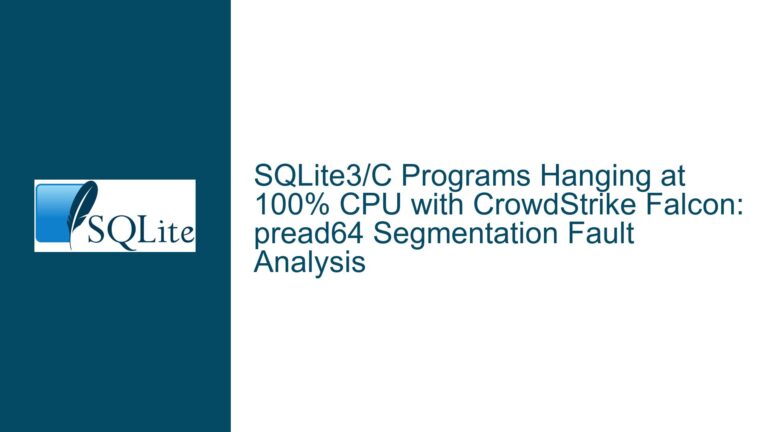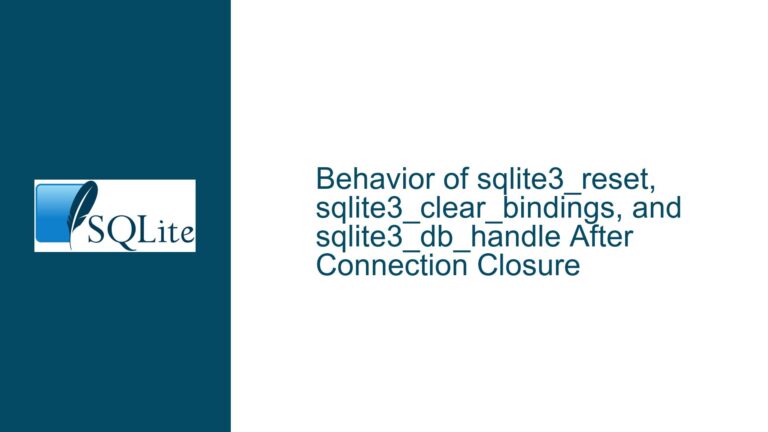SQLite SEH Compilation Issue: SQLITE_USE_SEH vs. SQLITE_OMIT_SEH
Issue Overview: SQLITE_USE_SEH and SQLITE_OMIT_SEH Misconfiguration in MSVC Compilation
When compiling SQLite with Microsoft Visual C++ (MSVC) on Windows, developers often encounter issues related to Structured Exception Handling (SEH). SEH is a Microsoft-specific mechanism for handling hardware and software exceptions, and SQLite provides compile-time options to control its usage. The core issue revolves around the misuse of the SQLITE_USE_SEH and SQLITE_OMIT_SEH preprocessor macros, which leads to compilation warnings and unintended behavior.
The SQLITE_USE_SEH macro is intended to enable or disable SEH support in SQLite. However, setting SQLITE_USE_SEH=0 does not effectively disable SEH, as evidenced by the presence of SEH-related symbols like __imp_RaiseException and __C_specific_handler in the compiled object files. Additionally, the compiler emits a warning (C4005) indicating a macro redefinition, which suggests that the macro is being defined multiple times with conflicting values.
The correct macro to use for disabling SEH is SQLITE_OMIT_SEH. This macro explicitly instructs the SQLite build system to omit SEH-related code, ensuring that no SEH symbols are included in the final binary. The confusion between these two macros stems from outdated or unclear documentation, which has since been corrected but may not yet be widely available.
Possible Causes: Misinterpretation of Compile-Time Options and Documentation
The root cause of this issue lies in the misinterpretation of SQLite’s compile-time options and the documentation surrounding them. The SQLITE_USE_SEH macro is often misunderstood as a toggle for enabling or disabling SEH, but its behavior is not as straightforward as it appears. When SQLITE_USE_SEH is set to 0, it does not fully disable SEH; instead, it leaves the door open for SEH-related code to be included in the build. This is because the macro is primarily designed to enable SEH when set to 1, and its behavior when set to 0 is not well-defined.
Another contributing factor is the documentation, which previously suggested using SQLITE_USE_SEH=0 to disable SEH. This recommendation was incorrect and has since been updated to reflect the proper usage of SQLITE_OMIT_SEH. However, developers relying on older versions of the documentation or community resources may still be using the outdated approach, leading to the issues described.
The compilation warning (C4005) further complicates the matter. This warning indicates that the SQLITE_USE_SEH macro is being redefined, which can occur if the macro is defined in multiple places with conflicting values. For example, if SQLITE_USE_SEH is defined in both the command-line arguments and the SQLite source code, the compiler will emit a warning to alert the developer of the conflict. This warning serves as a clue that the macro is not being used as intended.
Troubleshooting Steps, Solutions & Fixes: Correct Usage of SQLITE_OMIT_SEH and Avoiding Macro Redefinition
To resolve this issue, developers must ensure that they are using the correct compile-time options and avoiding macro redefinition. The following steps outline the proper approach to disabling SEH in SQLite when compiling with MSVC:
Use
SQLITE_OMIT_SEHInstead ofSQLITE_USE_SEH: The first and most critical step is to replace any instances ofSQLITE_USE_SEH=0withSQLITE_OMIT_SEH. This macro explicitly instructs the SQLite build system to omit SEH-related code, ensuring that no SEH symbols are included in the final binary. For example, when invoking the MSVC compiler, use the following command-line argument:/DSQLITE_OMIT_SEH.Remove Conflicting Definitions of
SQLITE_USE_SEH: IfSQLITE_USE_SEHis defined in multiple places, such as in the command-line arguments and the SQLite source code, it can lead to macro redefinition warnings. To avoid this, ensure thatSQLITE_USE_SEHis not defined anywhere in the build configuration. If it is defined in the SQLite source code, consider modifying the source code to remove the definition or conditionally define it based on the build environment.Verify the Absence of SEH Symbols: After compiling SQLite with
SQLITE_OMIT_SEH, verify that no SEH-related symbols are present in the object files or final binary. This can be done using tools likedumpbin(for object files) orobjdump(for binaries). Look for symbols like__imp_RaiseExceptionand__C_specific_handler, which should no longer be present if SEH has been successfully omitted.Update Documentation and Build Scripts: If the incorrect usage of
SQLITE_USE_SEHis embedded in documentation or build scripts, update these resources to reflect the correct usage ofSQLITE_OMIT_SEH. This will prevent future developers from encountering the same issue.Test the Build: After making the necessary changes, thoroughly test the SQLite build to ensure that it functions correctly without SEH. This includes running unit tests, integration tests, and any application-specific tests that rely on SQLite. Pay special attention to error handling and recovery scenarios, as these are the areas most likely to be affected by the absence of SEH.
Monitor for Compiler Warnings: Even after resolving the issue, continue to monitor for compiler warnings related to macro redefinition or other potential issues. These warnings can provide valuable insights into the build configuration and help identify other areas that may need attention.
By following these steps, developers can effectively disable SEH in SQLite when compiling with MSVC, avoiding compilation warnings and ensuring that the final binary is free of SEH-related code. This approach not only resolves the immediate issue but also promotes best practices for managing compile-time options and avoiding macro conflicts in complex build environments.
In conclusion, the key to resolving the SQLite SEH compilation issue lies in understanding the correct usage of SQLITE_OMIT_SEH and avoiding the pitfalls associated with SQLITE_USE_SEH. By carefully managing compile-time options, updating documentation, and thoroughly testing the build, developers can ensure a smooth and error-free compilation process. This meticulous approach not only addresses the current issue but also sets a foundation for maintaining robust and reliable SQLite builds in the future.






